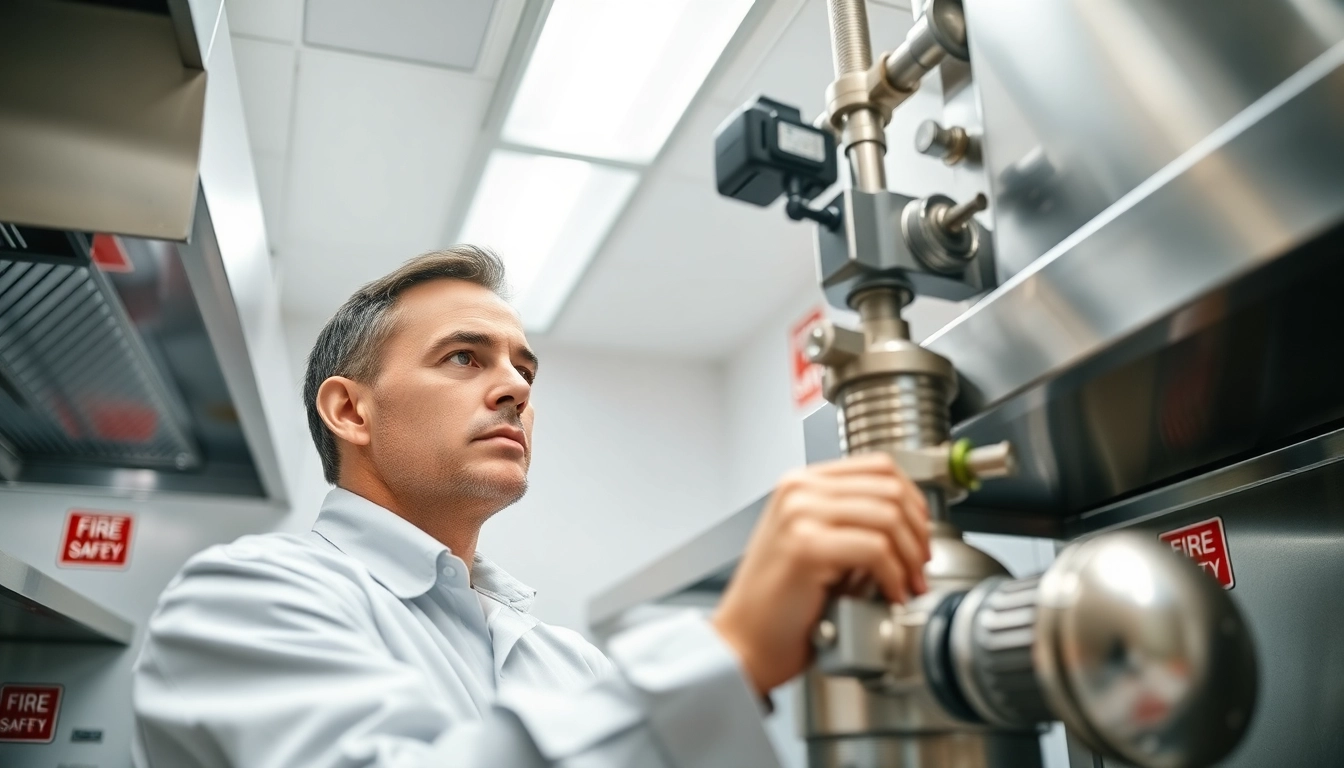Understanding Fire Suppression service
Definition and Purpose of Fire Suppression service
Fire Suppression service is a critical system designed to detect, control, and extinguish fires in both residential and commercial settings. The primary purpose of this service is to minimize the risk of loss of life and property damage in the event of a fire. Fire suppression systems encompass a wide range of technologies, from manual fire extinguishers to sophisticated automatic systems that activate without human intervention. Understanding the various facets of these systems is essential for any organization, particularly in industries that are more prone to fire hazards.
How Fire Suppression service Works
The functionality of a Fire Suppression service hinges on its ability to detect potential fires and deploy the appropriate extinguishing agent effectively. Systems typically integrate fire detection mechanisms such as smoke and heat detectors. Once a fire is detected, the system activates and releases extinguishing agents categorized as water, foam, chemicals, or gas. Each type of agent works differently: water cools the burning material, foam blankets the surface to smother flames, chemicals interrupt the combustion process, and gases displace oxygen to prevent fire escalation. For instance, in commercial kitchens, wet chemical suppression systems are commonly used due to their effectiveness against grease fires.
Importance of Fire Suppression service in Commercial Settings
In commercial settings, especially where flammable materials are processed or stored, the implementation of a reliable Fire Suppression service is non-negotiable. These systems help safeguard both human life and valuable assets from the devastating consequences of a fire. Additionally, having a robust fire suppression system in place can protect businesses from financial losses due to property damage and can enhance their reputation with clients and customers. Moreover, insurance companies often favor businesses with fire suppression systems, which can translate to lower premiums and easier compliance with safety regulations.
Types of Fire Suppression service Systems
Wet Chemical Fire Suppression service
Wet chemical fire suppression systems are predominantly used in commercial kitchens where cooking oils and greases are present. This system deploys a solution that not only extinguishes flames but also cools burning surfaces to prevent re-ignition. The wet chemical interacts with the grease and creates a barrier that smothers the fire. Regular inspections and maintenance of wet chemical systems are crucial to ensure their effectiveness, considering the high-temperature environments in which they operate.
Foam Fire Suppression service
Foam fire suppression systems are versatile and particularly effective in combating flammable liquid fires, such as those arising from fuel spills. These systems utilize a mixture of water and foam concentrate, which, once deployed, blankets the flammable material and starves the fire of oxygen. The benefits of foam systems extend to both their ability to quickly extinguish flames and their effectiveness in preventing the re-ignition of the fire, making them ideal for areas prone to combustible liquid hazards, including fuel storage facilities.
Clean Agent Fire Suppression service
Clean agent fire suppression systems utilize gaseous agents that are non-toxic and safe for humans and the environment. These agents, like FM-200 or Novec, work by inhibiting the combustion process on a molecular level. They are particularly well-suited for sensitive areas such as data centers, museums, and archives where water damage from traditional suppression methods could pose a greater risk than fire itself. Clean agent systems activate quickly and leave no residue, ensuring minimal disruption to operations.
Installation and Maintenance of Fire Suppression service Systems
Steps for Proper Installation of Fire Suppression service
The installation of fire suppression systems is a technical process that requires professional expertise. The first step involves conducting a thorough risk assessment of the facility to identify potential fire hazards. Following this, selecting the appropriate type of system tailored to those risks is crucial. The installation process typically includes mounting equipment, laying out piping or tubing, connecting to power sources, and integrating detection systems. All installations must comply with fire safety codes and standards to ensure efficacy and legality.
Regular Maintenance Checks for Optimal Performance
Regular maintenance of fire suppression systems is vital to ensure they function correctly in an emergency. Routine checks should involve inspecting the system’s operational components, replacing expired agents, and conducting functional tests of alarms and detectors. A maintenance schedule should be established based on the manufacturer’s guidelines and local regulations, ensuring that any wear and tear are promptly addressed. This proactive approach not only guarantees optimal functionality but also serves to fulfill legal compliance requirements.
Common Issues and Solutions in Fire Suppression service Maintenance
Several common issues may arise during the maintenance of fire suppression systems. These can include blocked nozzles, expired suppression agents, or faulty detection alarms. Addressing these issues typically involves a thorough inspection of the system, along with repairs and replacements as necessary. Employing licensed professionals to conduct maintenance can help avoid complications and ensure the system is in top working condition. It is highly recommended that records of all maintenance work be logged for accountability and compliance purposes.
Safety Regulations and Standards for Fire Suppression service
National Fire Protection Association (NFPA) Guidelines
The National Fire Protection Association (NFPA) provides a wealth of information and guidelines dedicated to various aspects of fire safety, including suppression systems. NFPA standards, such as NFPA 17A for wet chemical fire suppression systems, outline the design, installation, and maintenance protocols necessary for effective performance. Compliance with NFPA guidelines is often a requirement for insurance coverage and safety inspections, making it crucial for businesses to understand and adhere to these standards.
Understanding Local Fire Safety Codes
In addition to NFPA standards, local fire safety codes must also be taken into consideration. These codes can vary significantly between jurisdictions, often reflecting the specific fire risks present in the area. Businesses must familiarize themselves with local regulations to ensure they meet or exceed the minimum required standards for fire suppression systems. Working closely with local fire marshals or safety officials can enhance understanding and facilitate compliance.
Compliance and Inspections for Fire Suppression service
Regular compliance checks and inspections are integral to maintaining fire suppression systems effectively. These evaluations typically involve reviewing the system’s installation and operation against established codes and guidelines. Certified inspectors will conduct these reviews annually to ensure systems are in working order and properly maintained. Ensuring compliance also fosters a culture of safety within the organization, instilling confidence among employees and stakeholders alike.
Benefits of Professional Fire Suppression service
Protecting Assets and Lives through Fire Suppression service
The foremost benefit of a robust Fire Suppression service is the protection it affords to both human life and valuable assets. By effectively controlling fires before they escalate, these systems play a crucial role in safety management strategies, potentially saving lives and preventing significant financial losses. The presence of a reliable fire suppression system can also provide peace of mind to employees and customers, fostering a safe and reassuring environment.
Cost-Effectiveness of Investing in Fire Suppression service
Investing in a professional Fire Suppression service may seem costly upfront, but it is essential to consider the long-term savings it can provide. By preventing catastrophic fire events, businesses can avoid the substantial financial burdens associated with property damage, loss of inventory, and operational interruptions. In many cases, the cost of installing and maintaining fire suppression systems is outweighed by the protection they offer against losses incurred during a fire.
Enhancing Insurance Coverage with Fire Suppression service
Many insurance companies offer reduced premiums for businesses that demonstrate a commitment to fire safety through the installation of fire suppression systems. These systems are often viewed as a mitigating factor against the risks of fire-related losses, making insurance coverage more accessible and affordable. Moreover, having an established fire suppression service can streamline the claims process in the unfortunate event of a fire, as it shows that proactive measures were in place.



